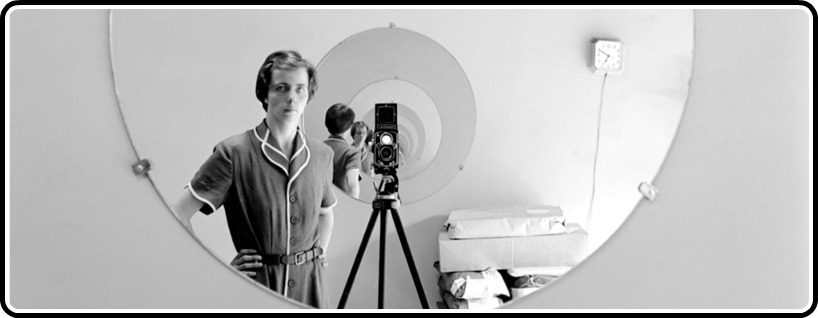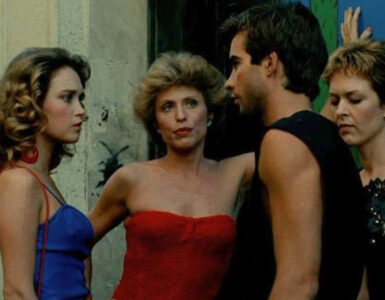
In 2007, young local Chicago real estate agent and historian John Maloof purchased roughly 30,000 prints and negatives from a local auction house. Upon realizing the girth and quality of the photographs now in his possession, he eventually purchased the rest of the boxes from the same buyer. Maloof now owned over 100,000 prints, negatives and undeveloped film rolls of one Vivian Maier as well as all personal belongings kept in her storage locker. Unable to find out anything about Maier, Maloof happened upon her obituary shortly afterward, giving him a foundation on which to access, preserve, arrange, and investigate her life and body of work. Knowing he owned something substantial, the photographs did not take long to gain traction, and in a short period of time Vivian Maier’s street photography gained worldwide attention.
Part of my attraction to Finding Vivian Maier is that it intrinsically addresses archival concepts such as provenance, establishing value, and the ethics of decision-making for the deceased. Despite some red flags as to what Maier may have wanted, the film makes the moderately convincing case that her posthumous exposure is ultimately a good thing. Her work gets immediate widespread recognition, the kind that pronounces her as a major figure in photography, while the crucial loss of anonymity blissfully comes after death. Of course it is easy to come to this conclusion when looking at the work, but it is more complicated than that.The small but important proof that she had inquired about her work being published at one point goes a long way to alleviate some uneasiness that may come with her involuntary exposure. The film rightly, and also in its best interests, makes a big deal of this discovery of unrealized intent. Being a form of promotion for Maier’s work, and being co-directed by Maloof, the film resolves itself in the name of good (it kind of has to, right?)
I know next to nothing about photography, but it’s apparent that Vivian Maier’s endless body of work is revelatory, something not even the art world can deny forever, though they will likely try. Some expansion on the art world’s resistance would have been welcome, although one gets the sense (not through this film, but just in general) their collective reasoning is often exclusive and elusive. Looking at her street photography, it doesn’t take long to be singularly struck by her ability to elevate the everyday with observed dignity. The subjects often waver between caught and aware, her expert timing and camera placement allowing her this middle ground. She often catches an innate tenderness in humanity just as often as the decrepit disarray and the inconsolable loneliness of others and their environments.
As much as Finding Vivian Maier is about the work, its primary focus is her life, or rather, our lack of knowledge on the woman behind the photos. Can we even begin to know and speculate about someone who was obsessively determined to remain anonymous? The answer is a resounding no. What the swathes of acquaintances, former children and employers (including Phil Donahue!) all recollect adds up to little concerning the mystery of Vivian Maier. Obsessive. Paranoid. Hoarder. Abusive. There are some basic constructed throughlines but nothing substantial, which I took to be the point of the film, purposeful or not. We get as much insight as we can, but the life she so desperately tried to keep under wraps remains so, even as she is now exposed to the general public. She kept her work, newspapers, and her everyday transactions intact, but the substance of a personal life or identity is systematically erased, nonexistent, or vague even down to the murky French accent and shapeless wardrobe. Her work remains the most telling, and surely it is fate to have someone as compulsive as John Maloof come into possession of her belongings and take up the major task of preserving and arranging her work.
So little is known about Maier that the ‘biographical’ aspects, which are less biography and more speculative reminiscing, are addressed by topic rather than a straightforward account of her life. The quirkiness of some of the interviewees is revealed but not exploited. Ample time is spent on Maier’s photographs, and the filmmakers never let the intrigue of her life quite overshadow her body of work. The construction of the narrative is admittedly uneven at times, such as when the filmmakers overtly play up eventual dead-ends, or fail to follow through on more unpleasant discoveries of abuse on the part of Maier.
Vivian Maier is exactly the kind of enigmatic recently discovered recluse, with a game-changing talent no less, that we can’t help but want to solve. She is a quintessential rabbit-hole subject for the endless nature/nurture unknowables of what makes a person who they are. Looking like Anna Massey’s long-lost cousin, she is a dream subject for a documentary. The film gets the best of both worlds in that it fuses two documentary tropes together; the spotlight on the undiscovered artist and the probing investigative mystery. Though the ethics of Maier’s involuntary exposure may be somewhat questionable, it simply feels right that this body of work is recognized, and all without Maier ever having to deal with the likely unlivable burden of being known.
Finding Vivian Maier is available in select theaters March 28th and VOD March 30th.





![Bergman Island (The Criterion Collection) [Blu-ray]](https://criterioncast.com/wp-content/uploads/2022/11/bergman-island-the-criterion-collection-blu-ray-400x496.jpg)
![This Is Not a Burial, It’s a Resurrection (The Criterion Collection) [Blu-ray]](https://criterioncast.com/wp-content/uploads/2022/11/this-is-not-a-burial-its-a-resurrection-the-criterion-collection-blu-ray-400x496.jpg)
![Lars von Trier's Europe Trilogy (The Criterion Collection) [The Element of Crime/Epidemic/Europa] [Blu-ray]](https://criterioncast.com/wp-content/uploads/2022/11/lars-von-triers-europe-trilogy-the-criterion-collection-the-element-of-400x496.jpg)
![Imitation of Life (The Criterion Collection) [Blu-ray]](https://criterioncast.com/wp-content/uploads/2022/11/imitation-of-life-the-criterion-collection-blu-ray-400x496.jpg)
![The Adventures of Baron Munchausen (The Criterion Collection) [4K UHD]](https://criterioncast.com/wp-content/uploads/2022/11/the-adventures-of-baron-munchausen-the-criterion-collection-4k-uhd-400x496.jpg)
![Cooley High [Criterion Collection] [Blu-ray] [1975]](https://criterioncast.com/wp-content/uploads/2022/11/cooley-high-criterion-collection-blu-ray-1975-400x496.jpg)